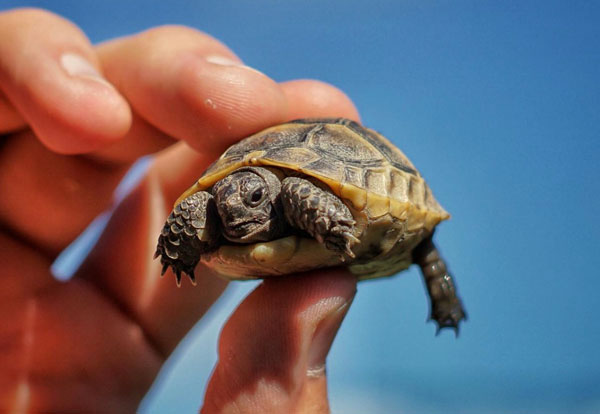Comprehensive Feeding Guide: What Do Baby Turtles Eat?
Understanding how to properly feed baby turtles is crucial for their health and well-being. This article provides detailed information on what baby turtles eat, how to feed them, and their specific nutritional needs, ensuring they grow strong and healthy.

What Do Baby Turtles Eat in the Wild?
In their natural habitats, baby turtles have a varied diet that changes as they grow. Hatchlings are generally omnivorous, consuming a mix of plants and animals to meet their nutritional needs. They start by eating small invertebrates like insects, tiny fish, and aquatic plants, which are easier to catch and digest.
Aquatic Insects: Baby turtles often feast on insects such as dragonfly larvae and water beetles. These are accessible and rich in proteins essential for their growth.
Tiny Fish: Minnows and other small fish forms part of the diet, providing a rich source of protein and essential fats.
Aquatic Plants: Algae and other soft aquatic plants are often consumed, offering necessary vitamins and fibers.
Wild baby turtles rely heavily on their environments to provide a balanced diet. They are opportunistic feeders, eating whatever they can find. This natural diet is typically well-rounded but may lack consistency due to environmental changes. Therefore, understanding their natural eating habits helps replicate a similar diet in captivity.
What Do You Feed Baby Turtles?
In captivity, providing a balanced diet is critical to mimic their natural food sources. Most commercially available turtle foods are engineered to provide essential nutrients, but they should not be the only food source. Mixing in fresh options ensures that baby turtles receive a well-rounded diet.
Commercial Turtle Pellets: These are designed to be nutrient-dense, offering a convenient feeding option for turtle owners.
Fresh Invertebrates: Foods like mealworms, earthworms, and small crickets provide necessary proteins much like their natural diet.
Vegetables and Greens: Leafy greens like lettuce, kale, and spinach are excellent sources of vitamins and should be chopped finely to avoid choking hazards.
Aquatic Plants: Introducing plants such as duckweed into the tank can replicate the wild eating environment and provide necessary nutrition.
A varied diet not only ensures all nutritional needs are met but also keeps the baby turtles engaged and stimulated through different textures and flavors.
How to Feed a Baby Turtle?
Feeding baby turtles correctly can be a bit nuanced, involving more than just offering food. The method of feeding impacts their health and enjoyment.

Right Size of Food: Tiny turtles need food cut into manageable pieces to prevent choking and ensure they can eat comfortably.
Feeding Environment: Some baby turtles prefer eating in the water while others might need a separate feeding area to avoid mess in the tank.
Feeding Tools: Tweezers can help place food in accessible positions, ensuring each turtle gets its share without aggression.
Observation: Always monitor feeding to ensure all turtles are eating and to watch for any signs of distress or disinterest in food.
Clean Up: Remove any uneaten food after feeding sessions to prevent water contamination which can lead to health issues for the turtles.
Following these practices can help maintain a healthy feeding routine, ensuring that every baby turtle receives adequate nutrition.
How Often to Feed Baby Turtles?
The frequency of feeding is vital to avoid both overfeeding and underfeeding. Young turtles need frequent meals to fuel their rapid growth.
Daily Feeding: For the first six months, baby turtles should be fed daily to meet their high metabolic needs.
Twice Daily: If possible, splitting their daily portion into two smaller meals helps with digestion and mimics their natural grazing behavior.
Observation of Appetite: Adjust feeding frequency based on the turtle’s appetite and growth. If they seem disinterested, reduce the quantity but not the frequency.
Growth Monitoring: Regularly check the growth charts and weight. Overweight turtles might need less frequent feeding while underweight turtles may require more.
Consistency and observation are key in determining the appropriate feeding schedule for baby turtles.
Nutritional Requirements of Baby Turtles
Understanding the nutritional needs of baby turtles helps in planning their diet. They need a balanced intake of proteins, fats, vitamins, and minerals.
Proteins: Critical for tissue growth and repair. Sources include insects, fish, and commercial pellets.
Fats: Necessary for energy and growth. Found in fish and some commercial foods.
Vitamins: Essential for immune system support and overall health. Leafy greens and vegetables provide these.
Calcium and Phosphorus: Important for shell and bone development. Can be supplemented through cuttlebone placed in the tank and calcium-rich foods.
Fiber: Assists with digestion and is found in aquatic plants and vegetables.
A deficiency in any of these can lead to health issues such as shell deformities, lethargy, and poor growth. Therefore, a balanced and varied diet is crucial.
Conclusion
Feeding baby turtles involves understanding their natural diet, providing a balanced variety of both commercial and fresh foods, and paying attention to their eating habits and nutritional needs. By following this comprehensive guide, you can ensure that your baby turtles grow up healthy and strong, enjoying a diet that closely mimics what they would consume in the wild.
FAQs
How do you take care of a baby turtle?
Baby turtles need a clean habitat, appropriate temperature and humidity, and a balanced diet. Ensure they have access to clean, fresh water and a basking area with a UV lamp for proper shell development.
Do baby turtles like lettuce?
Yes, baby turtles can eat lettuce, especially dark leafy varieties such as romaine. However, lettuce should not be their primary food source as it lacks comprehensive nutrition. It should be part of a varied diet.
How long can a baby turtle go without eating?
A healthy baby turtle can go about a week without food, though this is not ideal. Regular feeding is crucial to ensure they get the nutrients needed for proper growth and health.
